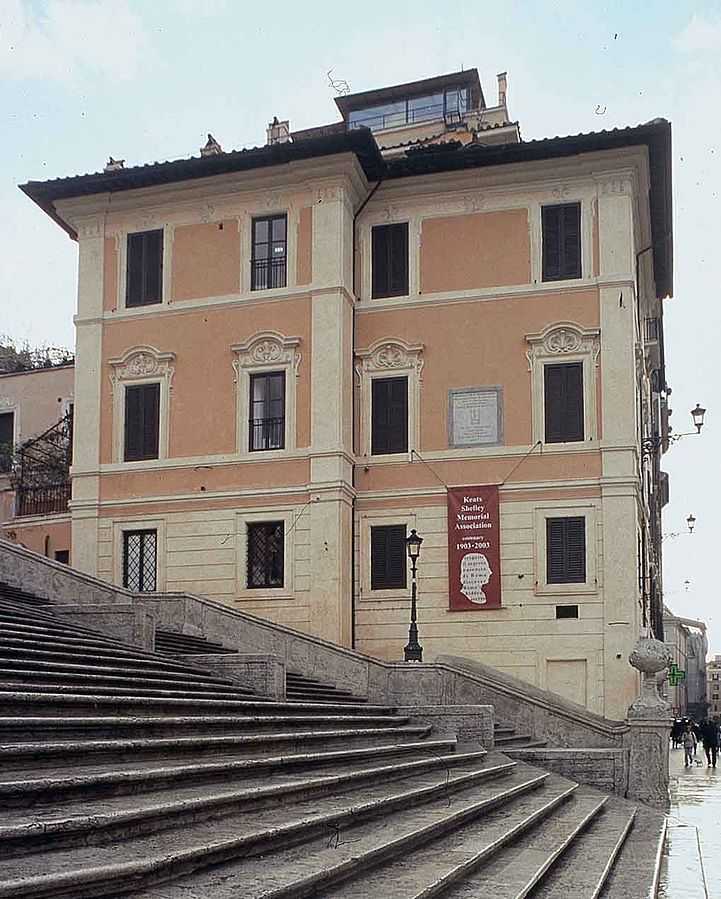Just off the Spanish Steps, this house where poet John Keats lived and died in 1821, at the age of 25, is dedicated to the British Romantic poets. Wander through this pretty little house which includes Keats's bedroom where he met his tragic death as well as memorabilia from poets such as Keats, Shelley and Byron, to learn more about the romantic poets and the influence Italy had.
Opposite the Fontana della Barcaccia, tucked into the side of the busy Spanish Steps, the Memorial House is where the poet John Keats died aged 25. As you visit, listen out to hear the fountain splashing outside, the same as Keats would have heard in his last few months.
Keats was born in today’s Moorgate, London, trained as a surgeon, but aged 21 he committed to a career in poetry. As a result of this choice, Keats was to spend his life in financial hardship. Part of the second-generation British romantic movement, Keats was snidely referred to as belonging to “the Cockney School” by critics, and never received fame in their lifetimes.
The second-generation British Romantic movement included Lord Byron and Leigh Hunt who, alongside Keats and Shelley, found that the older Romantics such as William Wordsworth had become too conservative in their views. The Romantic movement as a whole believed in human liberty but having lived through the violence of the French Revolution, the older generation became less radical.
The second-generation poets were politically progressive, and believed in utopianism. This is reflected in their poetry, which was inspired by passion and emotion as well as the “Mediterranean” and its Ancient Greek and Roman heritage (seen in Keats’ Ode on a Grecian Urn, 1819).
Keats’ political beliefs most likely contributed to his lack of recognition as a poet. After the Industrial Revolution, there was widespread unrest, particularly amongst the working class. To prevent potential revolution, the British Government punished those who published radical ideas, perhaps which probably explains why Keats did not find a lot of support. Furthermore as part of “the Cockney School”, Keats was thought to be badly educated (he attended a ‘minor’ boarding school rather than Eton or Harrow) and was not upper class, inviting additional criticism.
That said, after his death, Keats became much more widely regarded and was especially popular in the Victorian period. Today, the first line of his poem (To Autumn, 1819) is instantly recognisable: “Season of mists and mellow fruitfulness”, something which is testament to his talents.
Keats is thought to have developed TB in around 1818 and by 1820 he was advised to move to Italy for the warmer climate, arriving at what is now the Keats-Shelley Memorial House. He died in February 1821 and was buried in Rome’s Protestant Cemetery, which is definitely worth a visit too.
After his death, Shelley wrote the poem Adonais in tribute to Keats:
“Peace, peace! He is not dead, he doth not sleep -
He hath awakened from the dream of life –“
Shelley died young too, at the age of 29.
The Keats-Shelley memorial house was bought in 1906 and commemorates Keats and Percy Bysshe Shelley. It contains a huge collection of Keats and Shelley’s writing (both letters and manuscripts), paintings, and memorabilia including Keats’ death mask. What’s more, there are paintings from the artist Joseph Severn who lived and nursed Keats in Rome, as well as works from Robert Browning, Elizabeth Barrett, and Oscar Wilde in a wood-panelled library.

- Monday:
-
10:00 - 13:00
14:00 - 18:00
- Tuesday:
-
10:00 - 13:00
14:00 - 18:00
- Wednesday:
-
10:00 - 13:00
14:00 - 18:00
- Thursday:
-
10:00 - 13:00
14:00 - 18:00
- Friday:
-
10:00 - 13:00
14:00 - 18:00
- Saturday:
-
10:00 - 13:00
14:00 - 18:00
- Sunday:
- Closed




